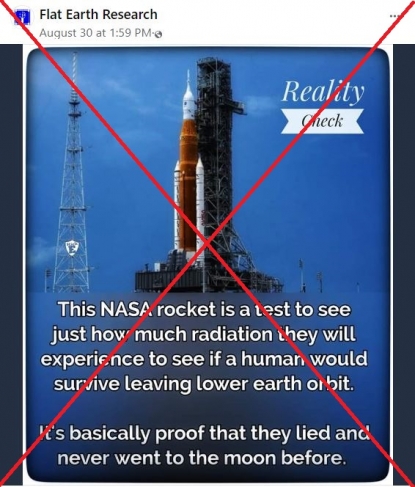Posts link NASA lunar radiation tests to ‘fake Moon landing’ conspiracy theory
Copyright AFP 2017-2022. All rights reserved.
Facebook posts circulating around the world claim a NASA mission to test the impact of space radiation on astronauts is evidence that human Moon landings were a hoax. However, the tests aim to measure radiation from longer trips to space, and tracking radiation is just one of the uncrewed mission’s aims. Conspiracy theories about Moon landings have been widely debunked.
“This NASA rocket is a test to see just how much radiation they will experience to see if a human would survive leaving lower earth orbit,” reads a Facebook post shared on August 30 to a page with more than 90,000 followers.
“It’s basically proof that they lied and never went to the moon before.”
As NASA prepares to return humans to the Moon, one of the biggest dangers future astronauts will face is space radiation that can cause lasting health effects.
The US space agency wants to develop a sustainable human presence on the Moon — where radiation is between two and three times higher than on the International Space Station — with missions lasting several weeks, compared to just eight days on the 1969 Moon landing.
The post shows a photo of the Artemis 1 mission, which hopes to test the Space Launch System rocket — the most powerful rocket in the world — and uncrewed Orion capsule that sits atop it.
The mission’s intended launch in August was pushed back after the rocket experienced technical glitches.
 A screenshot of the Facebook post with the false claim, captured on September 12, 2022
A screenshot of the Facebook post with the false claim, captured on September 12, 2022Facebook posts around the world shared the same claim, from Australia to Sri Lanka, the United States and Canada.
However, the claim is false.
The supposedly faked Moon landing is one of the most popular conspiracy theories, and alleges the images that NASA broadcast in July 1969 were shot in a Hollywood studio.
A string of false claims have been spread online by those looking to bolster the conspiracy over the years, which AFP has debunked here and here.
Professor Jack Burns, an astrophysicist at the University of Colorado Boulder said the conspiracy was “pure nonsense”.
“We have lots of proof that 12 Apollo astronauts visited the Moon and brought back lunar soil samples that are much different from that on Earth,” he told AFP.
Long-term radiation exposure
The Orion capsule will carry three dummies equipped with radiation sensors to record information for future crewed missions.
A mannikin wearing a full-body space suit will join two mannikin torsos known as “phantoms”, which are made from materials that mimic the bones, soft tissue and organs of women — who typically have greater sensitivity to space radiation than men, NASA says.
The agency said it wants to send the first woman and first person of colour to the Moon on future Artemis missions.
“For this particular mission, this would be the first time organ-specific dose is measured. This is courtesy of the thousands of detectors inside the phantoms,” said Duke University Professor Paul Segars, who has been involved in Artemis 1 radiation tests.
“You can’t do that with live people as you would need implanted detectors,” he told AFP.
The full-body mannikin will also be equipped with sensors to record acceleration and vibration throughout the mission.
Segars said that NASA has long monitored astronauts’ radiation exposure. The agency has published documents that show astronauts carrying radiation detection systems on previous Apollo missions.
But astronauts on future missions will be exposed to higher doses than on previous trips.
“With Artemis, astronauts will be spending months, even years on the Moon, so we need to understand the effects of long-duration radiation exposure,” Burns said.
Moreover, Artemis 1 does not only aim to test the effects of space radiation on astronauts.
The primary goals of the mission are to “demonstrate Orion’s systems in a spaceflight environment and ensure a safe re-entry, descent, splashdown, and recovery prior to the first flight with crew on Artemis II,” NASA said.
The agency said that the launch will “provide a foundation for human deep space exploration and demonstrate our commitment and capability to return humans to the Moon and extend beyond”.


